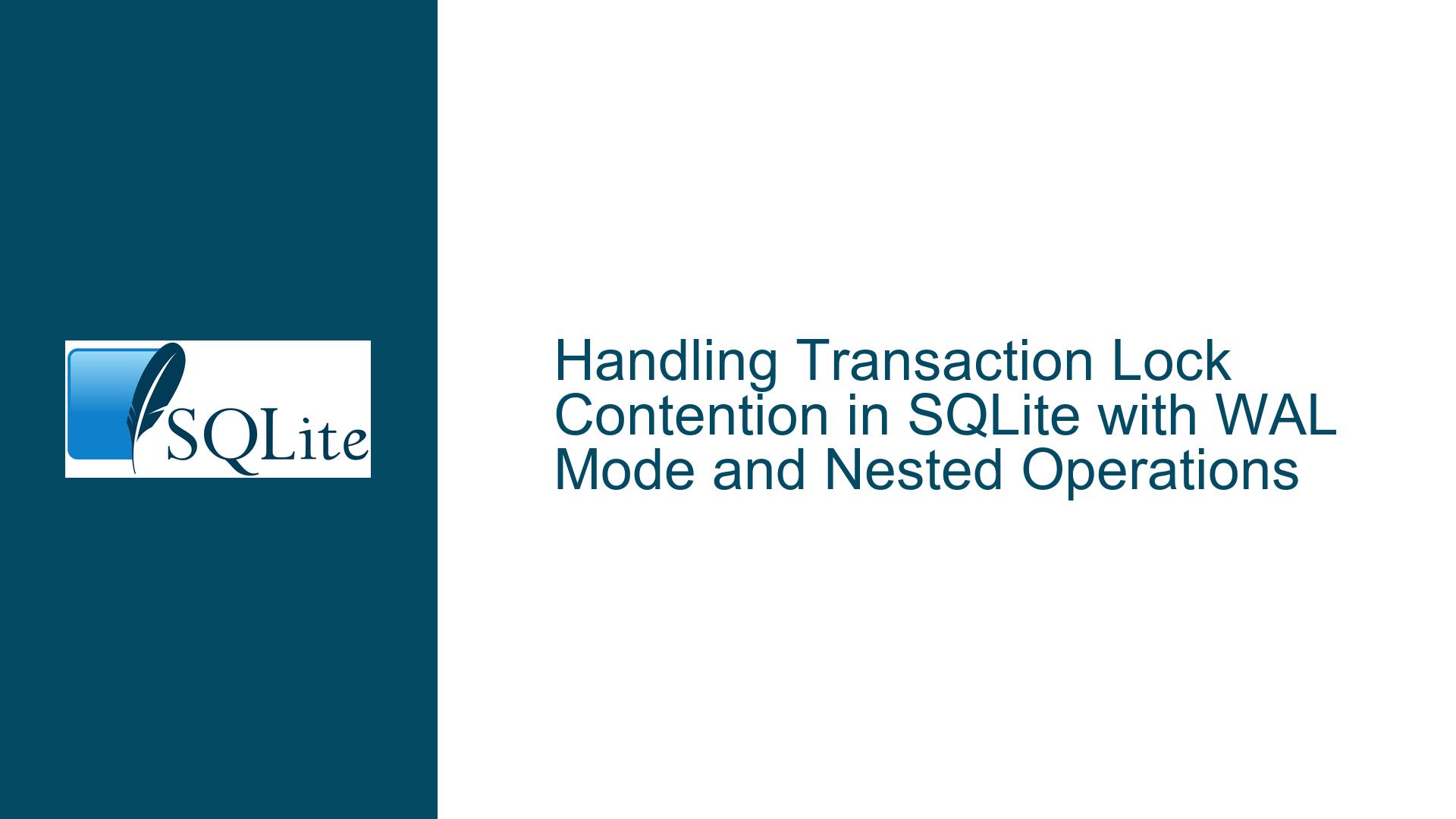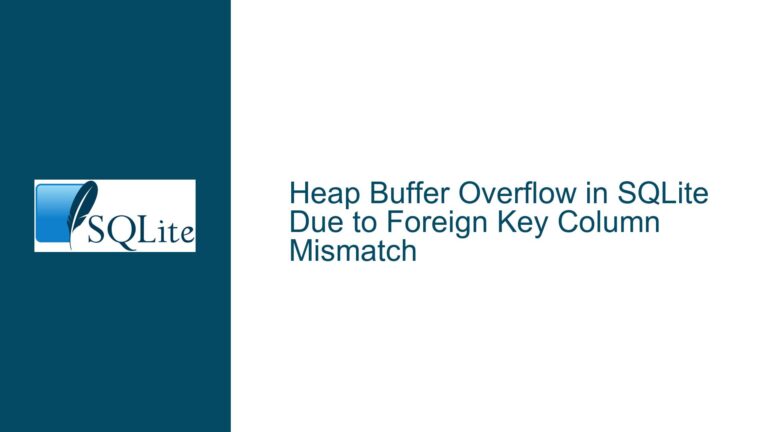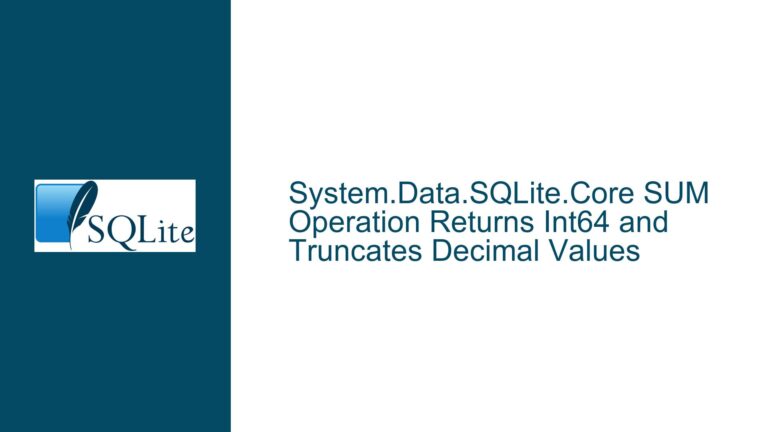Handling Transaction Lock Contention in SQLite with WAL Mode and Nested Operations
Understanding SQLite Transaction Locking Behavior in WAL Mode
Issue Overview
The core challenge involves managing database locks when using SQLite’s Write-Ahead Logging (WAL) mode with nested transactions or savepoints. In WAL mode, concurrent read and write operations are generally more efficient, but specific scenarios can lead to unexpected "database is locked" errors. For example:
- Process 1 starts a
SAVEPOINT, performs aSELECT, and does not immediately acquire a write lock. - Process 2 modifies the database during this window.
- Process 1 later attempts a write operation, encountering a lock conflict because the initial
SAVEPOINTdid not preemptively secure the necessary locks.
The root of the problem lies in SQLite’s default deferred transaction model. Transactions (or savepoints) begin in DEFERRED mode, which does not acquire locks upfront. Instead, locks are obtained incrementally: a SHARED lock for reads and a RESERVED/EXCLUSIVE lock for writes. In WAL mode, EXCLUSIVE locks are not required for writers, but conflicts arise when a read transaction (Process 1) holds a SHARED lock while a write transaction (Process 2) modifies the database. This creates a race condition where the initial read transaction cannot upgrade to a write lock later.
The original proposal to extend SAVEPOINT with IMMEDIATE or EXCLUSIVE modes aims to resolve this by allowing nested transactions to preemptively acquire stronger locks, similar to BEGIN IMMEDIATE. However, SQLite’s current design does not support this syntax, forcing developers to rely on workarounds.
Mechanics of Lock Contention and Savepoint Limitations
1. Transaction Locking Modes in SQLite
SQLite supports three transaction types:
- DEFERRED: Acquires no locks initially; upgrades to
SHARED(read) orRESERVED(write) as needed. - IMMEDIATE: Acquires a
RESERVEDlock immediately, allowing reads but blocking otherIMMEDIATEorEXCLUSIVEtransactions. - EXCLUSIVE: Acquires an
EXCLUSIVElock, preventing all other write transactions.
In WAL mode, EXCLUSIVE locks are not used for writes. Instead, writers use RESERVED locks, and conflicts occur when a reader holds a SHARED lock while a writer attempts to commit.
2. Savepoints vs. Transactions
Savepoints allow nesting within a transaction but do not independently manage locks. A SAVEPOINT inherits the lock mode of the enclosing transaction. If no transaction is active, a SAVEPOINT starts an implicit DEFERRED transaction. This implicit behavior is problematic because it defers lock acquisition, leading to conflicts under concurrency.
3. The Challenge of Library Code and Nested Operations
Library functions often cannot assume whether they are executing inside an existing transaction. Using BEGIN IMMEDIATE unconditionally would conflict with an outer transaction, while relying on SAVEPOINT risks lock contention. This forces developers to implement state tracking logic to decide whether to start a transaction or a savepoint.
4. Race Conditions in Autocommit Detection
Detecting whether a transaction is active (via sqlite3_get_autocommit or APIs like in_transaction()) is not atomic. A race condition can occur if another process starts a transaction after the check but before the current process acts.
Resolving Lock Contention: Strategies and Code-Level Fixes
1. Explicit Transaction Control with BEGIN IMMEDIATE
If a function or code block requires write access, explicitly starting an IMMEDIATE transaction ensures the RESERVED lock is acquired upfront. Example in Python:
def update_data(db):
try:
db.execute("BEGIN IMMEDIATE")
# Perform read and write operations
db.execute("COMMIT")
except sqlite3.Error as e:
db.execute("ROLLBACK")
This approach avoids lock upgrades but requires that the function know it is not already inside a transaction.
2. State Tracking for Nested Operations
For reusable code that may be called inside or outside a transaction, track transaction state programmatically. Use a wrapper to manage savepoints or transactions:
class TransactionManager:
def __init__(self, db):
self.db = db
self.active_transactions = {}
def begin_step(self, name):
if self.db.in_transaction:
self.db.execute(f"SAVEPOINT {name}")
self.active_transactions[name] = False # Marks a savepoint
else:
self.db.execute("BEGIN IMMEDIATE")
self.active_transactions[name] = True # Marks a top-level transaction
def commit_step(self, name):
if self.active_transactions.get(name):
self.db.execute("COMMIT")
else:
self.db.execute(f"RELEASE {name}")
def rollback_step(self, name):
if self.active_transactions.get(name):
self.db.execute("ROLLBACK")
else:
self.db.execute(f"ROLLBACK TO {name}")
self.db.execute(f"RELEASE {name}")
3. Atomic Lock Acquisition with Retry Logic
To avoid race conditions, combine state checks with immediate lock acquisition attempts:
def atomic_begin(db):
max_retries = 3
for _ in range(max_retries):
try:
db.execute("BEGIN IMMEDIATE")
return True
except sqlite3.OperationalError:
# Another process holds the lock; retry
time.sleep(0.1)
return False
4. Custom SQLite Functions for Transaction State
Extend SQLite with User-Defined Functions (UDFs) to expose internal transaction states. Example C extension:
#include <sqlite3ext.h>
SQLITE_EXTENSION_INIT1
static void getTxnState(sqlite3_context *ctx, int argc, sqlite3_value **argv) {
sqlite3 *db = sqlite3_context_db_handle(ctx);
sqlite3_result_int(ctx, sqlite3_txn_state(db, NULL));
}
int sqlite3_extension_init(sqlite3 *db, char **errmsg, const sqlite3_api_routines *api) {
SQLITE_EXTENSION_INIT2(api)
sqlite3_create_function(db, "txn_state", 0, SQLITE_UTF8, NULL, getTxnState, NULL, NULL);
return SQLITE_OK;
}
This allows queries like SELECT txn_state() to check if a transaction is active.
5. Forcing Exclusive Locks in WAL Mode
While WAL mode avoids EXCLUSIVE locks, adding PRAGMA locking_mode=EXCLUSIVE forces the database to hold a lock indefinitely after the first write. This is heavy-handed but eliminates contention:
PRAGMA locking_mode = EXCLUSIVE;
6. Connection Pooling with Dedicated Writers
Assign specific connections for write operations and others for reads. This ensures writers always use IMMEDIATE transactions:
from threading import Lock
class ConnectionPool:
def __init__(self, db_path):
self.read_conn = sqlite3.connect(db_path)
self.write_conn = sqlite3.connect(db_path)
self.write_lock = Lock()
def write(self, query):
with self.write_lock:
self.write_conn.execute("BEGIN IMMEDIATE")
# Execute query
self.write_conn.commit()
7. Timeout and Busy Handler Configuration
Use sqlite3_busy_timeout() or PRAGMA busy_timeout to reduce contention errors. This makes SQLite retry locked operations:
db = sqlite3.connect("file:db?mode=rw", uri=True)
db.execute("PRAGMA busy_timeout = 5000") # Retry for 5 seconds
8. Avoiding Savepoints for Critical Writes
If savepoints are causing issues, refactor code to use flat transactions. Reserve savepoints for non-critical operations where rollbacks are acceptable.
Final Recommendations
- Use
BEGIN IMMEDIATEfor write-heavy code paths. - Implement transaction state tracking in reusable libraries.
- Avoid lock upgrades by preemptively acquiring stronger locks.
- Consider custom extensions or connection pooling for high-concurrency environments.
- Test timeout and retry logic under load to balance throughput and latency.
By understanding SQLite’s locking mechanics and adopting proactive transaction strategies, developers can mitigate "database is locked" errors while leveraging the benefits of WAL mode.






